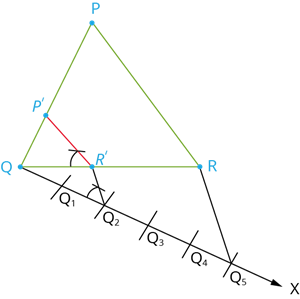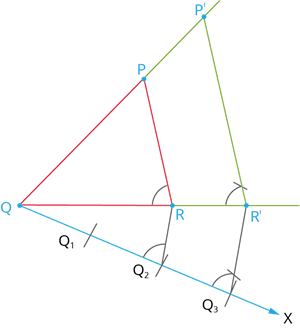UPSKILL MATH PLUS
Learn Mathematics through our AI based learning portal with the support of our Academic Experts!
Learn moreA scale factor is the ratio of similar figures' corresponding sides.
In the above theoretical material, we deal with similar triangles theoretically. Let us discuss how to construct a similar triangle using the concept of the scale factor. There are 2 cases.
Let us understand the cases using examples.
Example:
Case 1: If the scale factor is less than 1.
Construct a triangle similar to the given triangle PQR with its sides equal to \frac{2}{5} of the corresponding sides of the triangle PQR.
Solution:
Given a triangle PQR. We are required to construct another triangle whose sides are \frac{2}{5} of the corresponding sides of the triangle PQR.

Construction:
Step 1: Construct a triangle PQR with any measurement.
Step 2: Draw a ray QX making an acute angle with QR on the side opposite to vertex P.
Step 3: Locate 5 (the greater of 2 and 5 in \frac{2}{5}) points. Q_1, Q_2, Q_3, Q_4 and Q_5 on QX so that QQ_1 = Q_1Q_2 = Q_2Q_3 = Q_3Q_4 = Q_4Q_5.
Step 4: Join Q_5R and draw a line through Q_2 (the second point, 2 being smaller of 2 and 5 in \frac{2}{5}) parallel to Q_5R to intersect QR at R'.
Step 5: Draw a line through R' parallel to the line RP to intersect QP at P'. Then, P'QR' is the required triangle, each of whose side is two - fifths of the corresponding sides of \triangle PQR.
Let us consider the construction of triangle ABC using the scale factor \frac{3}{4}.
Case 2: If the scale factor is greater than 1.
Construct a triangle similar to a given triangle PQR with its sides equal to \frac{3}{2} of the corresponding sides of the triangle PQR.
Solution:
Given a triangle PQR. We are required to construct an another triangle whose sides are \frac{3}{2} of the corresponding sides of the triangle PQR.

Construction:
Step 1: Construct a triangle PQR with any measurement.
Step 2: Draw a ray QX making an acute angle with QR on the side opposite to vertex P.
Step 3: Locate 3 (the greater of 2 and 3 in \frac{3}{2}) points. Q_1, Q_2, and Q_3 on QX so that QQ_1 = Q_1Q_2 = Q_2Q_3.
Step 4: Join Q_2 (the 2nd point, 2 being smaller of 2 and 3 in \frac{3}{2}) to R and draw a line through Q_3 parallel to Q_2R, intersecting the extended line segment QR at R'.
Step 5: Draw a line through R' parallel to the line RP intersecting the extended line segment QP at P'. Then, P'QR' is the required triangle, each of whose side is three - twos of the corresponding sides of \triangle PQR.
Let us consider the construction of triangle ABC using the scale factor \frac{5}{3}.